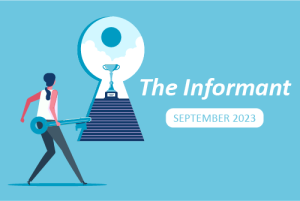Proactive management of mental health issues in the workplace
July 29, 2015The Informant: Issue 7
Over the course of the past decade, mental health has transformed from being a poorly understood and largely taboo topic in the workplace to becoming an accepted and important factor central to both workforce well-being and risk management.
Employers now realise that it is essentially inevitable that workplaces will be affected by mental health conditions; they can occur in any person, at any time. Rather than being a “problem” without a solution, businesses are also beginning to embrace the concept that with careful management and with the proper structures in place to support them, an employee impacted by mental health issues can be an effective member of their workforce.
According to the Australian Bureau of Statistics, whilst people unemployed or not in the paid workforce represent the highest rates of mental disorder – almost one in five Australians report experiencing symptoms of a mental disorder and those with a mental disorder spend on average three days out of their role every four weeks.1
A recent study by PWC and Beyond Blue has shown that for every dollar invested into workplace mental health initiatives, a business can see on average a return of $2.30 in benefits to the business. In view that mental health issues cost Australian businesses approximately $10.9 billion each year, there is also clear financial motivation for Australian businesses to look at strategies to reduce this impact.
Why invest in this issue?
Why should a business spend money on mental health initiatives? Where does the $2.30 return on investment come from? To understand the answers to these question, consider the core areas in which the “costs” of mental health issues arise, being:
- Absenteeism ($4.7 billion annually): Absenteeism not only costs businesses’ in terms of paid leave, but has a fundamental impact on productivity. At its essence, the business is of course paying a person for zero productivity output.
- Presenteeism ($6.1 billion annually): Presenteeism measures where an employee is at work, but operating less productively because of the presence of a mental health condition.
- Compensation ($145.9 million annually): these are typically claims made through workers compensation or other claims / actions for mental health-related conditions.
It follows then that if a business can develop a targeted strategy on initiatives that support mentally ill employees, they can expect to see a return on investment by a reduction in these three cost centres.
How to detect and manage mental health issues in the workplace?
Mental health issues usually vary in prevalence and type depending on the industry that a business operates in. Typically the more common types of mental health issues are anxiety disorders, affective disorders (comprised of mood disorders such as depression) and substance use disorders. But how can a business identify and respond to these issues effectively?
Understanding the mental health conditions of your workplace
Emerging research has identified psychosocial factors that act as strong indicators of the mental health conditions in the workplace, impacting on workers’ psychological responses to work and work conditions, which then potentially cause psychological health problems. Psychosocial factors include the way work is carried out (such as deadlines, workload, and work methods) and the context in which work occurs (including relationships and interactions with managers and supervisors, co-workers and clients or customers).
A detailed analysis of the impact of psychosocial factors in a workplace or within a work group can assist with early detection, ongoing management and possible resolution of mental health issues. This analysis, a “mental health audit”, can be conducted by an experienced professional to assess the potential risk, and impact of, psychosocial factors identified in a workplace and provide the business with an understanding of the likely triggers, causes or risk scenarios for mental health issues arising or being exacerbated.
A mental health audit can be implemented as both a reactive measure as well as a proactive tool used by progressive workplaces to both address cultural problems within a workplace or group of employees, as well as identify risk profiles for certain working environments so that control measures can be implemented. Conducting a detailed audit can also be an integral part of a broader proactive approach to WHS, which of course forms part of the overarching obligations on an employer to take steps to provide a working environment where identifiable risks to health and safety are controlled.
Awareness and support
In addition to an analysis of the psychosocial factors at play in the work environment, effective and appropriate policies and procedures are the cornerstone for creating awareness of mental health issues in the workplace.
Other mechanisms designed to build awareness include employee communications (such as notices or company-wide emails providing details of employee assistance programs or other support programs) or regular participation in mental health events, such as “Movember” or “R U OK?” day. These initiatives are designed to increase awareness and break down the barriers employees may see in communicating with their employers about mental health issues in the workplace.
Larger businesses can focus on training managers to identify and assist with the basics of managing mental health issues within work groups; knowing when to have a conversation with an employee around mental illness, looking at how their role may be adjusted to reduce the risk of mental illness, implementing structured return to work plans etc. Smaller to medium-sized businesses may in fact find it easier to accommodate the above actions because, in our experience, the most critical success factor is employee participation, support and flexibility.
There are clear cultural benefits and costs savings to be gained for businesses who are prepared to dedicate time and resources to better understand and manage mental health issues in the workplace. Management of mental health and well-being is rapidly emerging as a subset in the practice of Human Resources, in many ways similar to Diversity and Equal Opportunity programs and initiatives that now feature as a core Human Resource function in many progressive workplaces.
Are you facing a mental health issue in your business? Would you like to talk to us about how to manage the situation? Please call us on (02) 9922 5188 or email us at info@fcbgroup.com.au.

























